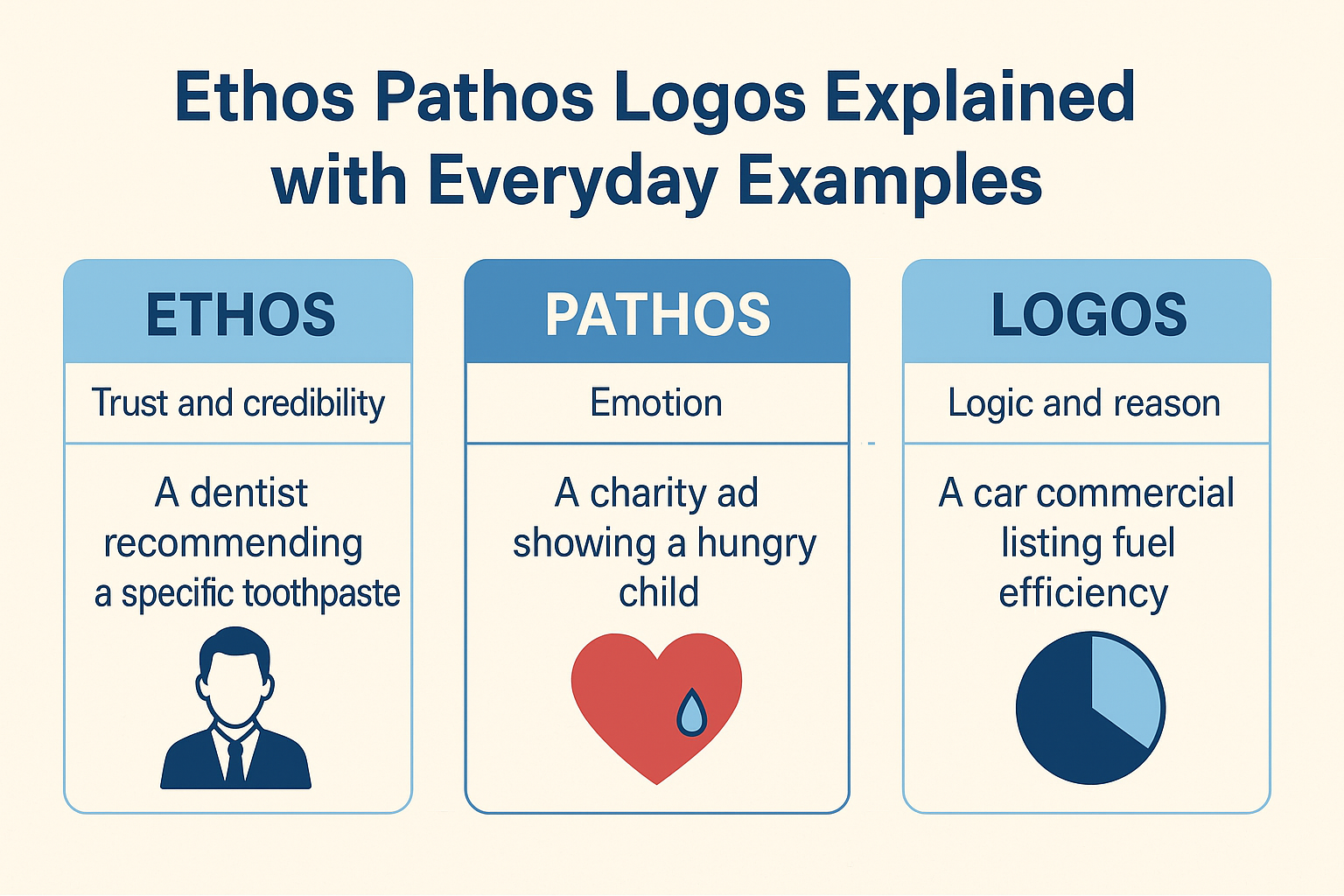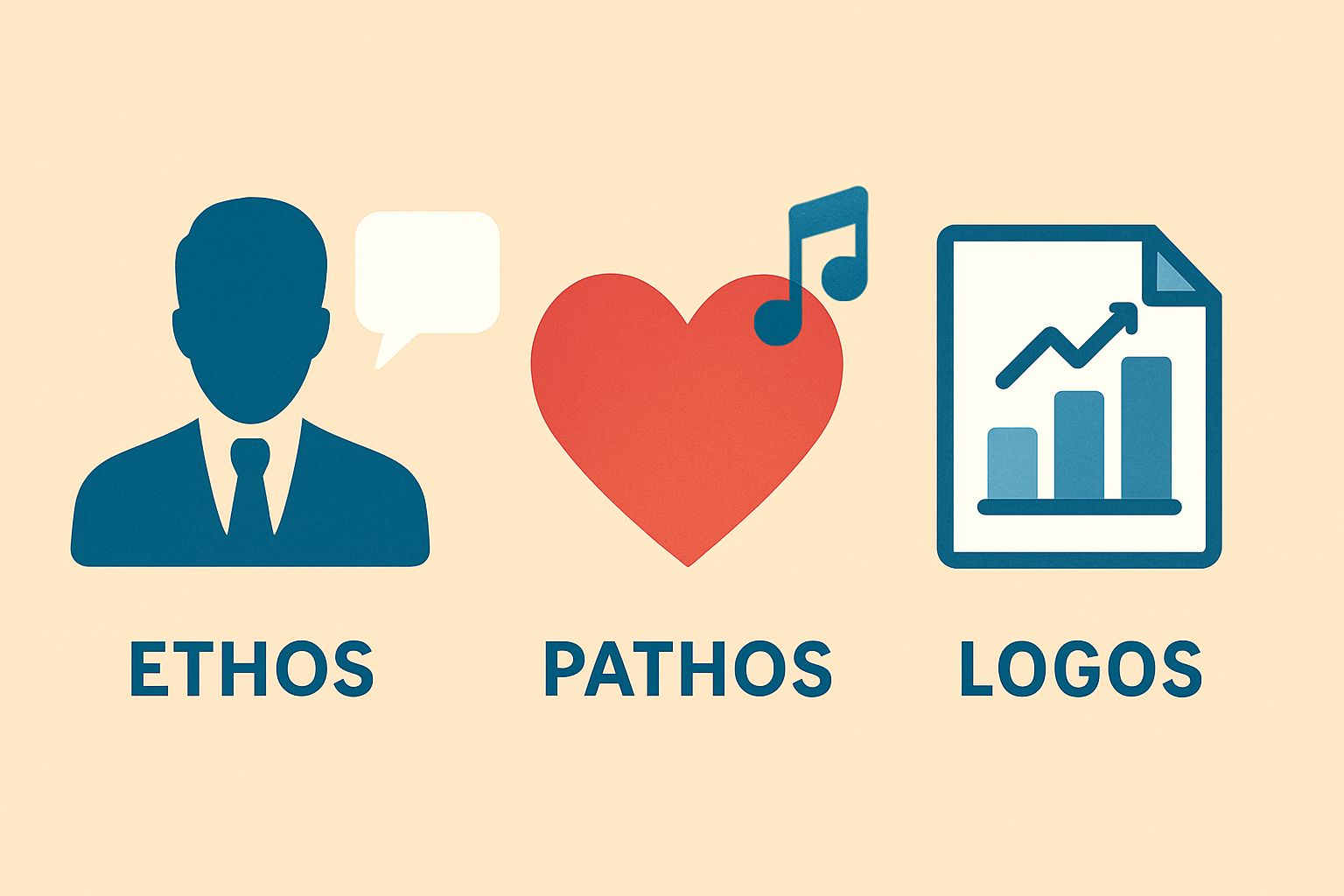You hear it all the time—people trying to convince you to buy something, agree with an idea, or take action. Behind most of those persuasive messages is a trio that’s been working its magic since the days of ancient Greece: ethos pathos logos. These aren’t just fancy words your high school English teacher threw around. They actually show up in your daily life way more than you think. Let’s unpack what they mean using plain language and real-world examples that make sense.
| Type | What It Means (With a Dash of Fun) |
|---|---|
| Ethos | “Trust me, I’ve got a degree!” – It’s all about credibility. We believe folks who know their stuff. |
| Pathos | “Cue the sad music…” – This one tugs at your heart and hits you right in the feels. |
| Logos | “Let me show you the data.” – Brings the logic, the numbers, and the “aha” moments. |
What Is Ethos?
Ethos is the art of persuasion built on trust, experience, and credibility. It shows up whenever someone earns your confidence just by who they are or what they’ve done. You’re more likely to listen to someone who has real-world experience, a solid reputation, or a clear track record. That’s how ethos works. It makes people think, “I believe this person because they’ve earned it.”
You don’t have to be famous or hold a fancy title to have ethos. People notice how you carry yourself, how clearly you communicate, and whether you seem honest and consistent. The stronger that impression is, the more influence you have.
Examples of Ethos in Daily Life:
A dentist recommending a specific toothpaste in a commercial.
Most people don’t question it because a dentist is assumed to have professional training. That white coat, calm voice, and polished smile all work together to build credibility. It’s not just a sales pitch—it feels like expert advice.A CEO writing a blog post about their company’s values.
A CEO isn’t just another employee—they’re the face of the company. So when they talk about the brand’s goals or what it stands for, people pay attention. The position itself creates a sense of authority. Readers assume the CEO has insight into what’s really going on behind the scenes.A friend who’s a mechanic suggesting which oil to use for your car.
You don’t need a certificate to earn someone’s trust—just experience. If your friend has spent years fixing engines, their opinion on motor oil is going to mean more than whatever label is on the bottle. You trust them because you’ve seen them in action.
Ethos builds a bridge between the speaker and the listener. It makes people more open, more willing to hear the message, and more likely to believe it’s worth their time. And the best part? Once someone has strong ethos, they don’t need to shout or oversell—they already have your attention.

What Is Pathos?
Pathos connects through emotion. It grabs your attention by making you feel something—sadness, joy, anger, pride, fear, or even hope. This kind of persuasion doesn’t rely on facts or titles. It speaks straight to your gut. It’s the reason you tear up during a commercial or feel fired up after watching a powerful speech. Pathos doesn’t need to explain; it just makes you care.
It works because people are emotional creatures. Decisions aren’t always based on logic—they’re often driven by how something makes us feel. That’s why emotional appeal is used in everything from marketing to personal conversations. You remember how something made you feel long after the details are gone.
Examples of Pathos in Action:
A charity ad showing a hungry child with sad music in the background.
You don’t need statistics to feel the weight of that moment. The image of a child, paired with slow music and a soft voice asking for help, creates an emotional response. It’s not trying to convince you with data—it just wants you to feel the urgency and act from the heart.A movie trailer that gives you goosebumps or makes you laugh.
Great trailers are built to stir emotion. If a scene brings tears to your eyes or gives you chills, you’re more likely to remember it—and want to see the full movie. You’re not buying a ticket because of facts. You’re buying into the feeling.A social media post about a pet rescue story.
Picture a scruffy dog shivering in the rain, followed by a photo of that same dog smiling in a new home. That emotional contrast creates a strong connection. You feel happy, maybe a little proud, even though you didn’t know the dog. That’s pathos doing its job.
Pathos doesn’t just ask you to listen. It gets you to care. It’s the emotional nudge that turns attention into action.
What Is Logos?
Logos uses logic to make its point. It brings out the facts, the comparisons, and the straightforward arguments. You won’t find emotional language here—it’s about reasoning that makes sense. Logos appeals to the part of the brain that wants proof. If something adds up, it earns your attention.
This kind of persuasion is common in debates, advertising, product comparisons, and even casual arguments. People use logos when they want to show that their side has structure and makes sense. It’s not about how it feels—it’s about whether it holds up.
Examples of Logos in Everyday Situations:
A car commercial listing fuel efficiency, safety ratings, and price.
Instead of showing a celebrity behind the wheel, this kind of ad gives you facts. “This model gets 40 miles per gallon and has a 5-star safety rating.” That kind of info helps you weigh your options. You’re not being pushed—you’re being informed.A debate where one side presents facts and statistics.
Think of a student in a classroom debate who brings a list of sources, charts, and examples. That person isn’t relying on emotional appeal or reputation—they’re letting the numbers talk. Logos helps prove a point by keeping the conversation focused on logic.A product page that compares features side by side.
You’ve seen those charts: Product A vs. Product B. Size, price, warranty, battery life—it’s all laid out so you can make a decision based on what’s there. It feels like you’re making a smart, informed choice. That’s logos at work.
Logos gives your brain a checklist to follow. It turns persuasion into something that feels fair and balanced. No fluff, no tricks—just structure and sense.

Why Ethos Pathos Logos Still Work Today
Think about it: you’re scrolling online, and someone’s reviewing a product. If they’re an expert or have used it a lot (ethos), you take them seriously. If they tell a touching story about how it changed their life (pathos), you feel something. And if they break down the pros and cons or compare it with others using solid info (logos), it seals the deal.
That’s the power of ethos pathos logos—they hit you from every angle. And it’s not manipulation. It’s how humans process and decide what’s worth their time.
How Advertisers Use Ethos Pathos Logos All the Time
Think about your favorite brands. They almost always mix these three in their messaging.
A typical ad campaign might include:
A celebrity (ethos) saying they use the product.
A touching story (pathos) showing how it helped someone.
Bullet points (logos) listing what makes it better than competitors.
That’s a triple hit. They’re covering all bases, so you feel good, trust the message, and think it makes sense.
Spotting Ethos Pathos Logos in Social Media
Let’s break it down even further. Every scroll through your feed is packed with ethos pathos logos, whether you notice or not.
Examples:
Ethos – An influencer says, “As a certified nutritionist, I recommend this.”
Pathos – A viral post shares a story of overcoming tragedy to inspire.
Logos – A tweet comparing two products side-by-side using real stats.
Social media is one giant persuasion playground.
How to Use Ethos Pathos Logos in Your Life
It’s not just about spotting these tricks—it’s also about using them yourself. Maybe you’re writing a cover letter, making a speech, or even negotiating with your partner. Knowing how to mix ethos pathos logos can seriously improve how people respond to you.
Tips to Apply Ethos Pathos Logos:
Want credibility? Mention your experience or quote experts.
Want to connect? Tell a real, relatable story.
Want to convince? Use real data or a logical structure.
Here’s a quick cheat sheet for how to plug them into what you say or write:
| Persuasion Type | What to Use | Why It Works |
|---|---|---|
| Ethos | Authority, reputation, credentials | Builds trust and credibility |
| Pathos | Personal stories, emotions, vivid words | Creates connection and empathy |
| Logos | Stats, charts, clear reasoning | Appeals to common sense and facts |

Balancing All Three for Best Results
Here’s the thing—using just one isn’t usually enough. If you’re all emotion with no facts, people might think you’re being dramatic. If it’s all stats with no human connection, you sound robotic. And if you rely only on reputation, people may question your motives.
The magic is in the blend. A good speaker, writer, or influencer uses a mix of ethos pathos logos to keep things balanced and persuasive.
Why Kids and Teachers Use Ethos Pathos Logos Too
It’s not just for professionals or marketers. Even kids use these techniques without knowing it.
Think about a child asking for a dog:
“I’ll take care of it” (ethos).
“It would make me so happy” (pathos).
“Dogs help reduce stress” (logos).
That’s a solid pitch! And teachers? They use ethos by showing they care and know their stuff, pathos by encouraging students emotionally, and logos by presenting the material in a clear, logical way.
Final Thoughts on Ethos Pathos Logos in Your Everyday Life
You don’t need a philosophy degree to understand ethos pathos logos. These ideas are baked into how we talk, think, sell, argue, and connect. Once you start noticing them, you’ll see them everywhere—from billboards and YouTube ads to TED Talks and text messages. And the best part? You can start using them more intentionally right now to be more convincing, relatable, and clear in everything you say or write.




